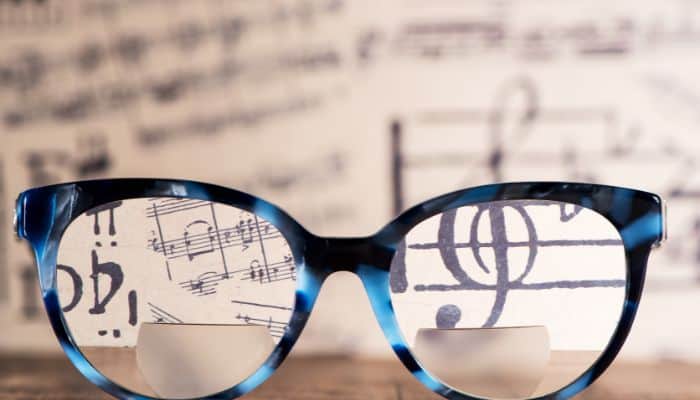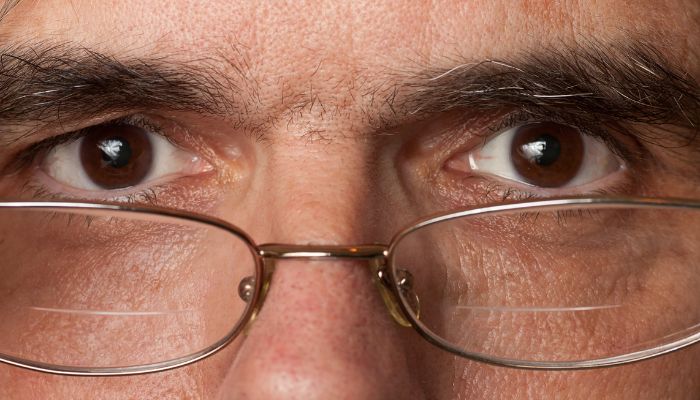(This page contains affiliate links. OGR may receive compensation if you click a link and make a purchase.)
Bifocal glasses, also known as bifocals, are eyeglasses that combine two types of corrective lenses into one frame.
The upper part of each lens corrects for distance vision and the lower portion contains the power for your reading prescription.
Bifocals are easily recognizable, as they have a visible line that separates the two different types of lenses:

The way it works is that the user can switch their gaze from the top portion of the lens to the bottom, depending on what they need to focus on.
For example, when trying to read a book, you would look down through the lower part of the lens. If you’re walking or driving, you would look through the upper portion, which would help you to focus on objects in the distance.
Who Should Wear Bifocals?
If you’ve worn single-vision lenses to correct nearsightedness most of your life, you may find it getting increasingly difficult to read up close without taking your glasses off or switching to a pair of reading glasses.
This is a common sign of presbyopia, which starts affecting most people around the age of 40-45.
Bifocals are an excellent solution for those with presbyopia, as they allow you to focus on objects both far away and nearby without having to switch glasses or take them off.
Signs You Need Reading Glasses
What Kinds of Bifocals Are There?
Over-The-Counter Bifocals
Non-prescription bifocal reading glasses have no vision correction in the top part of the lens, with just the magnification power segmented at the bottom.
These are great if you don’t need correction for distance vision but want to be able to switch between reading and watching tv without taking your reading glasses off, for example.
You can buy non-prescription bifocal glasses at most drug stores and online.
Prescription Bifocals
If you do need vision correction for distance, your eye doctor can provide you with a prescription for bifocal glasses.
The nice thing about prescription bifocals is that they are tailored to your specific vision needs and provide the most accurate correction.
Once your prescription is determined, you can then look for frames that are compatible with bifocal lenses.
The good news is, many frame styles – including designer and rimless or semi-rimless frames – are now compatible with bifocal lenses, so you don’t have to sacrifice fashion or style for function.
Bifocal Lens Designs
The most common is the flat-top bifocal, where the reading lens looks like a D-shape on its side. This is the most traditional style of bifocal lens and what most people choose.

The other popular type of bifocal is called an “executive” lens, which looks like an upside-down trapezoid and provides a wider area for near vision. The reading lens usually covers the entire bottom part of the lens.
Advantages of Bifocals
One of the biggest advantages of bifocals is that they offer a convenient solution for those who need vision correction for both distance and close ranges but don’t want to have to switch between two pairs of glasses throughout their day.
Bifocals are more economical than other multifocal lenses or progressives. If you don’t want to spend the money on more technologically advanced or complex lenses, bifocals are the way to go.
Finally, bifocals are easier to adjust to than progressive lenses, due to the simpler design and larger viewing area of each segment.
Disadvantages of Bifocals

One of the main disadvantages of bifocals is that it can take some getting used to, especially if you’re used to wearing single-vision glasses.
It may feel strange or awkward at first, as you adjust your gaze from the upper portion to the lower portion of the lens.
Another potential issue with bifocals is that the visible line can be distracting and can create visual distortions in specific situations.
For example, if you’re climbing stairs, you’re likely looking down through the bottom part of the lens, which can make it difficult to accurately judge the height of each step.
Bifocals are also considered less attractive visually speaking as they advertise that you’re a certain age, or make you look older than you are.
In Summary
Overall, bifocals are a good vision solution for those who need help seeing far and near while still being cost-effective.
However, it’s important to keep in mind that bifocals can take some getting used to and may not be the most attractive option.
If you have any questions or concerns about whether bifocals are right for you, it’s always best to consult with your eye care professional.